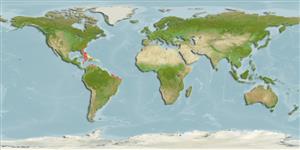>
Anguilliformes (Eels and morays) >
Ophichthidae (Snake eels) > Ophichthinae
Etymology: Apterichtus: From the Greek απτερόν (apteron), without fins, and ίχθύς (ichtus, more correctly written ichthys; masculine), fish..
Environment: milieu / climate zone / depth range / distribution range
Ecologia
marino demersale; distribuzione batimetrica 1 - 38 m (Ref. 101270). Subtropical; 37°N - 33°S, 81°W - 33°W
Western Atlantic: USA (from the Carolinas and southern Florida Keys), Bermuda, Bahamas, Lesser Antilles, and off Brazil.
Size / Peso / Age
Maturity: Lm ? range ? - ? cm
Max length : 54.0 cm TL maschio/sesso non determinato; (Ref. 7251)
Short description
Morfologia | Morfometria
Vertebre: 123 - 132. This elongate species is distinguished by the following characters: tail 1.7-1.8, head 12-15, and body depth 43-53 in total length; preopercular pores 4 and pores in supratemporal canal 5; teeth conical, uniserial on jaws and vomer; vomerine teeth 3-4 ; body coloration is nearly uniform pale to tan, fresh specimens have a fine sprinkling of melanophores over the dorsal surface of the head and body, with pale areas behind eye and along lower jaw; MVF 54-128, total vertebrae 123-132 (Ref. 101270).
Burrows in sand in surf areas.
Life cycle and mating behavior
Maturità | Riproduzione | Deposizione | Uova | Fecundity | Larve
Distinct pairing (Ref. 205).
McCosker, J.E. and Y. Hibino, 2015. A review of the finless snake eels of the genus Apterichtus (Anguilliformes: Ophichthidae), with the description of five new species. Zootaxa 3941(1):49-78. (Ref. 101270)
IUCN Red List Status (Ref. 130435)
Threat to humans
Harmless
Human uses
Informazioni ulteriori
Age/SizeAccrescimentoLength-weightLength-lengthLength-frequenciesMorfometriaMorfologiaLarveDinamica popolazioni larvaliReclutamentoAbbondanzaBRUVS
BibliografiaAcquacolturaProfilo di acquacolturaVarietàGeneticaElectrophoresesEreditarietàMalattieElaborazioneNutrientsMass conversion
Strumenti
Special reports
Download XML
Fonti Internet
Estimates based on models
Preferred temperature (Ref.
123201): 17.9 - 27.3, mean 24.8 °C (based on 155 cells).
Phylogenetic diversity index (Ref.
82804): PD
50 = 0.5000 [Uniqueness, from 0.5 = low to 2.0 = high].
Bayesian length-weight: a=0.00089 (0.00039 - 0.00204), b=3.00 (2.80 - 3.20), in cm total length, based on LWR estimates for this (Sub)family-body shape (Ref.
93245).
Trophic level (Ref.
69278): 4.0 ±0.7 se; based on size and trophs of closest relatives
Resilienza (Ref.
120179): Medio, tempo minimo di raddoppiamento della popolazione 1.4 - 4.4 anni (Preliminary K or Fecundity.).
Fishing Vulnerability (Ref.
59153): Moderate vulnerability (42 of 100).
